#kakuko
Explore tagged Tumblr posts
Note
Hey! Do you have any information regarding Rotten Heaven and their creations? I specifically would like to know more about Busuko and Honue. Thank youuu <3
Hi, I'm not sure exactly what kind of info you're looking for so I'll just go with a basic introduction of the Artist and his contribution to Ukagaka.
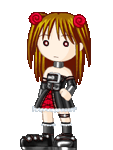
Rotten Heaven is a website created by artist Watazou/Wat 「real name: Tomohiko Watanabe」. The website was created in 2001, firstly as a tripod website and got delete somewhere in late 2016. The website mainly served as a diary, gallery and download site for his creations.
About: Watazou is a sucker for metal music (who would've thought ?) his favorite groups being Death Angel, Exodus, Alice in Chains, Megadeth, etc. He also loves Vocaloid, most notably Miku & Luka, drawing various fanart & having a collection. He also wrote in his dairy about events and festivals he went to. Wat also was a fan of Hellboy and Mike Mignola. On his Twitter he has been posting a lot about Uma Musume: Pretty Derby.
Watazou was very active in the Ukagaka community, he notably created various original Ukagaka Ghosts over the years which were all very complete.
🥀The Toxic Waltz [2001]

"Slash-hardcore clothing and fast-paced animation, high tension and angry conversations will transport you to a world that cannot be replicated. She is also known for her funny interactions with other Ghosts, and is in any case a ghost with a high degree of communication excellence."
Ghost consisting of Busuko "Diva Satanica" her companion Honeyu and her sisters, Kusuko "Chemical Warfare" & Kakuko "Atomic Smasher". An additional shell would later be created for Busuko, called Busyakko or Yakko for short.

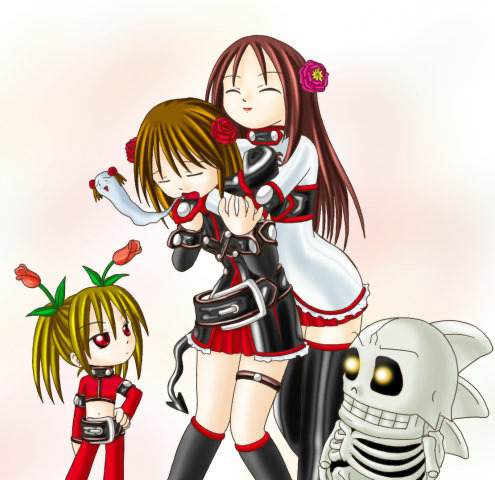
Left: Busyakko - Right: Busuko, her sisters & Honeyu
🦴Hone Hone Oyako [2006]

Ghost consisting of Honeyu and his daughter Honue who can also be spotted in the Ghost The Toxic Waltz, randomly appearing. She features multiple Outfits which are randomised at launch.
🪦RottenHeaven - Graveyard Lovesong [2008]

Ghost consisting of RottenHeaven, a living dead girl, inspired by the Frankenstein's monster & her companion Heartache. RottenHeaven's scripts are mostly written in Hiragana/Katakana with no Kanji.
Un addition to that, he also created a number of Ghosts, notably clock ones, Shells for Ghosts such as 54 or Talker, a Ghost named "Raven" for the baseware Crow, participated in art books and drew fanart of various other Ghosts. His own creations, most Notably Busuko for The Toxic Waltz was featured in many fanart within the community and fan games such UkaSamsh & U-New de Bomber XP. A fansite The Toxic Alliance (毒子同盟) would even be created by fans of The Toxic Waltz
On a last note, Wat notably collaborated with Ryūō Zero/Zero-r, creator of the Ghost Blood Tea House, to create a series of merch featuring Busuko & Urako for the Ukagaka Anniversary Event of 2012.
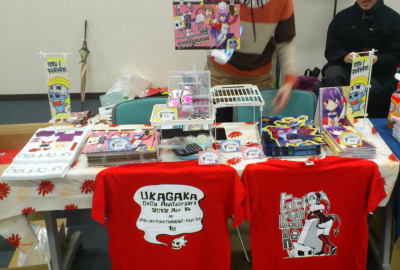
And there you go, I hope this answers some of your questions, there's definitely some information that I haven't seen being shared by many users before so that should teach people a few things. Looking into this made me love Watazou's work even more.
HAVE A GOOD FRIENDLY VIOLENT FUN !

#up#伺か#ukagaka#website#info#artist:watazou#made in rotten heaven#rottenheaven#the toxic waltz#busuko#kusuko#Kakuko#Honeyu#hone hone oyako#honue#rotten heaven#graveyard lovesong
36 notes
·
View notes
Text


#godzilla#minilla#gabara#godzilla's revenge#all monsters attack#kaiju#toho kaiju#daikaiju#tokusatsu#godzilla suit actors#suit actors#suitmation#haruo nakajima#masao fukazawa#yasuhiko kakuko#i just adore these pictures :)
12 notes
·
View notes
Text

@moonknightproductions here ya go!

kakuko narisawa (成澤覚子, narisawa kakuko), seat 14 of class 2-B at UA!
quirk: sense enhancement
kakuko can enhance one of her senses at the (temporary) expense of another. she tends to stick with the classic 5 due to ease and familiarity, but is branching out in order to become a better hero. overuse of her quirk can make her senses either deadened or over sensitive for a period of time proportional to the quirk activation time. she has been advised not to pursue hero work for too long.
kakuko became a huge fan of the wild wild pussycats after being rescued by them when she was younger and wants to join their agency one day. she already picked out a name fitting—bramble. she also has an ideal (purple!) costume to fit but can’t use it as student to avoid public confusion. but in the meantime she has interned there and enjoys rescue work.
she appears perpetually annoyed but does not have a bad impression of her class. closest with shizuka moto.
kakuko was accepted into ua on recommendation.
(fun fact! her birthday is july 31st!)
(send a number from 1-30 to learn about a bnha oc!)
#gari draws#gari’s ocs#bnha#mha#bnha oc#mha oc#oc: kakuko narisawa#i dont think i’ve ever drawn kakuko with her tie#she’s not particularly rebellious but she fucking hates the sensation of it around her neck#so when absolutely necessary she’ll put it on but she won’t be happy#i made voiceclaims a while ago which i might update since they’re all from like 3 anime but her vc is#mutsumi tamura who voices kanamori in keep your hands off eizouken!#she is an only child 👍🏽#her first name references the word for sense which is 感覚#覚 by itself can be used for the verb to remember#idr why i picked her last name. maybe attitude maybe it was a common enough last name
4 notes
·
View notes
Text




Street of Love and Hope (1959)
6 notes
·
View notes
Text
Kenji Mizoguchi's 'The Story of the Last Chrysanthemum' – sacrificing all for art on Criterion Channel
Kenji Mizoguchi, one of the masters of Japanese cinema, had already made 50 films by the time he made The Story of the Last Chrysanthemum (Japan, 1939), a drama of art, love, and sacrifice that has been called his first genuine masterpiece and is considered by many critics his greatest film. It’s the story of spoiled, arrogant actor Kikunosuke (Shôtarô Hanayagi), the adopted son of a great…
#1939#Blu-ray#Criterion Channel#DVD#Japan#Kakuko Mori#Kenji Mizoguchi#Shôtarô Hanayagi#The Story of the Last Chrysanthemum#VOD
0 notes
Text




Ukagaka The toxic waltz - X’mas Busuko & Kakuko shell
15 notes
·
View notes
Photo

Japanese textile artist Kakuko Ishii.
18 notes
·
View notes
Photo

Patreon sketches and few pages of next update!
Check it out~
28 notes
·
View notes
Text
「ukagaka smash ex 」 end credits
i love this video a lot, to me, it completely represents the spirit of ukagaka. a project created by a group of small artists, no big budget just the determination to do somethig great and celebrate the community ! and for something that i believe was made in mspaint, it looks really good =)
#ukagaka#games#dairantou uka smash ex#circle:micro dream studio ++#mikage sakura#unyuu#ex ice zero#ogitsuki#futaba#tadakichi#tototan#karasu#kimuraya anko#giko neko#busuko#kakuko#damien#mimimi#aoi sora & aryuu sensei#nini tan/sakura
37 notes
·
View notes
Text
Rize’s Rebirth
In the final arc of Tokyo Ghoul :re, a number of plot points were left unanswered. The most prominent and mysterious of these points was Rize Kamishiro, who was the driving plot point of the arc. After Kaneki (who became a one-eyed ghoul by having Rize’s Kakuhou implanted into him) ingested the Oggai (who each had a Kakuhou of Rize’s as well) and a “core” from Furuta’s body, he transformed into an enormous Kakuja called “Dragon.”

After Kaneki was extracted the Kakuja dissolved, but it left behind a number of oviducts that continued to function. The core of the 19th ward oviduct turned out to be Rize herself.

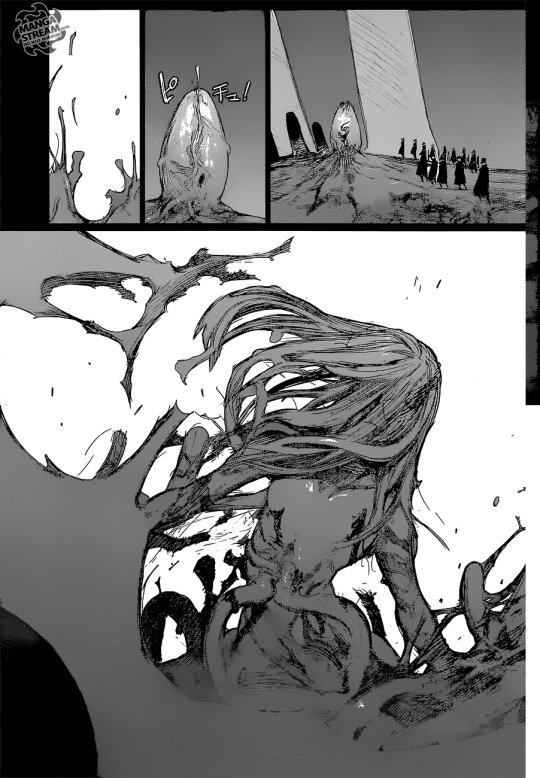

However, if you look closely at the egg membrane in the first panel, you’ll notice that there doesn’t appear to be a body inside. There are merely tentacles writhing around, but these tentacles consolidate and then Rize herself burst out of the egg. This suggests Rize was formed from the egg rather than already being present in it. But how could Rize have been “formed” if she already existed? Also, why did she later form strange, animalistic features when she was confronted by Kaneki?

“The core”
As shown in the first image above, Kanou stated the final step towards creating Dragon was a “core” placed in Furuta’s body. @littlemissymonster once speculated that this core could have been Rize’s main Kakuhou. In the series, it’s confirmed that severely damaging or destroying the kakuhou is a death sentence for a ghoul.


During Nishiki and Kurona’s fight with Roma on Rushima Island, Kurona tries to pierce the latter’s Kakuko because it would presumably be fatal. In the original series, Nashiro is unable to recover after having most of her Kakuko destroyed. Also, in one of the Tokyo Ghoul novels (Void), a ghoul named Noyama dies after Kaneki eats his Kakuho. However, there are also references in the series to ghouls that have multiple Kakuho sacs.


Eto (and later Yoshimura who posed as her) was determined to have 6-8 kakuho during her initial battles with the CCG. Later, during Kaneki’s battle with Shinohara in Kanou’s lab, Shinohara suspects Kaneki has multiple kakuho after he unveiled a new kagune form.
For six months prior to the battle in Kanou’s lab, Kaneki engaged in several acts of cannibalism to increase his ghoul abilities. This consumption of excess rc cells is likely what caused the formation of new kakuhou beyond the original one he received from Rize. The same is likely for Eto as she grew up in the 24th ward where it’s said cannibalism is common place.
However, this creates some confusion. In several places it’s mentioned that damaging the kakuho can be fatal. In addition to the above examples, it’s mentioned that in Yoshimura’s first fight with Arima his kakuhou received “lethal” damage. However, Shinohara managed to destroy a few of Kaneki’s kakuhou during their fight, but he continued fighting just fine. It seems that only if a ghoul’s original kakuhou (not those formed by excess consumption) is damaged then it is lethal.
This would explain why Rize was able to survive multiple Kakuhou extractions. After Furuta dropped steel beams on Rize in the first chapter, she was handed over to Kanou to extract her kakuho to create one-eyed ghouls. While Rize was never stated to be a cannibal, she did eat several times the number of humans a normal ghoul typically eats (hence her title “Binge Eater”). This could lead to the formation of extra kakuho, and so for Kanou’s experiments he would extract these extra kakuho to implant into humans. By leaving Rize’s original, or main, kakuho alone he could keep her alive and wait for these extra kakuho to grow back for further extraction.
So, the “core” that Kanou implanted into Furuta was likely Rize’s main kakuho. Extracting this would lead to her death, and this was necessary for Furuta’s plan to resurrect her (will explain below).
RC Cells as Memory Cells
In a ghoul biology post by @coromoor, it’s hypothesized that rc cells are a type of blood stem cell. This is evidenced by their presence in the bloodstream, their appearance being similar to blood cells affected by sickle-cell anemia, and their ability to regenerate multiple types of tissue.
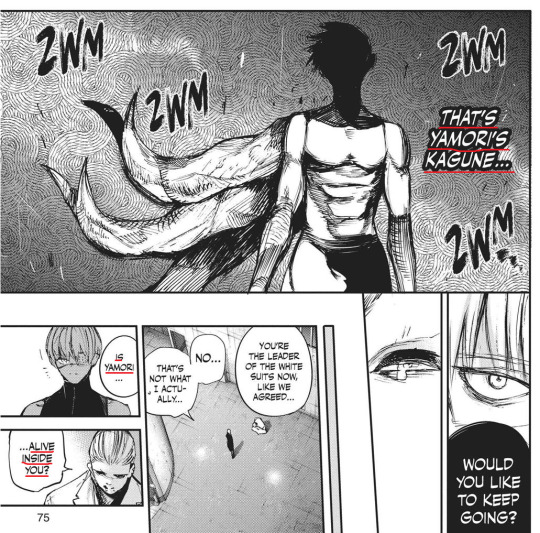

Stem cells are able to differentiate into any type of cell. This includes memory cells, and if rc cells are a type of stem cells than this explains why Kaneki (who has Yamori’s rc cells as he ate his kakuhou) is able to replicate Yamori’s kagune.
This would also explain Kaneki’s visions of Rize. In part 1, whenever Kaneki was in a mentally low state, a vision of Rize would appear and speak with him. If rc cells also double as memory cells, then this could explain these visions. As Kaneki had Rize’s kakuhou (and therefore her rc cells) he also had her memories inside of him.

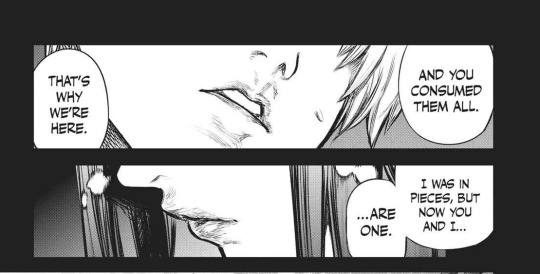
Later, when Kaneki is inside the Dragon in part 2, he has another vision of Rize. She refers to the Oggai as “small coffins.” A coffin is a container for dead remains, and this further supports the idea that she died after her her “core” (main kakuhou) was extracted from her body to be implanted into Furuta. However, her core and dozens of her other kakuhou have now been reunited inside of Dragon.
One of the panels shown at the beginning of this post showed Rize’s body forming inside of an egg. If rc cells are stem cells, then they can differentiate into any cell or tissue type (skeletal, muscle, blood, brain, etc.). By bringing together so many of Rize’s rc cells, it’s essentially created her a new body. It created a new Rize.
When this new body is formed, it’s still lacking its lower half. However, when Kaneki encounters it in :re 178 it appears more developed. It seems the purpose of Dragon was to gain energy (by eating humans) so Rize could be fully reformed.
Purpose of the Resurrection
All of this begs the question: why would Furuta go to all this trouble of resurrecting her when he could have avoided killing her in the first place?

It’s implied that continually extracting kakuho on a ghoul has negative impacts on their mental health. In a flashback in :re 65, Shachi mentions that Yoshimura’s kakuho is constantly being extracted by the Aogiri Tree (for One-Eyed Ghoul experiments). He says this has left him incognizant (lacking knowledge or awareness). This suggests the extractions have left him in a vegetative state.

This seems to be the same case for Rize (who also suffered from multiple extractions). While Furuta is talking to her in :re 119, she doesn’t acknowledge him or any of her surroundings.
Furuta’s goal from the beginning was to overthrow the Washu clan and to destroy the system they created, and to do this he needed Rize’s kakuho. However, he was also in love with Rize (having helped her escape the Sunlit Garden) and wanted to marry her. So, he used her to destroy the “cage” created by the Washu and V by unleashing the Dragon. Then, he planned to use the same Dragon to resurrect her so he could be with her.

In the end, all Furuta really wanted was a normal life.

#tokyo ghoul#tokyo ghoul :re#tokyo ghoul meta#tokyo ghoul :re meta#tg meta#tgre meta#rize kamishiro#nimura furuta#ken kaneki#akihiro kanou#kurona yasuhisa#nashiro yasuhisa#eto yoshimura#arima kishou#yamori#shachi#tokyo ghoul biology#oggai#yukinori shinohara#roma hoito
237 notes
·
View notes
Text
「頭」を使う日本語表現・japanese expressions that use 頭
こんばんにちは!(笑) 戻ってきましたよ。今は暇があるから、よく使うつもりです。
身体の部位の名称を使う表現を学んでいます。今日は「頭」からです。その前に、新しい単語を。
表現 〖 ひょうげん 〗 expression.
名称 〖 めいしょう 〗 name, title, word for something.
部位 〖 ぶい 〗 part (of the body), cut of meat.
身体 〖 からだ、しんたい 〗 生き物の体。

頭が…
頭がいい・頭のいい (is) bright, smart. 「でも大丈夫だよ。律が一緒にいるんだか���!」
「弟くんに何ができるんだ?」
「律が頭がいいんだ!」
頭が痛い 〖 いたい 〗 having a headache, inducing a headache.
頭がおかしい (is) crazy, insane.
頭が固い 〖 かたい 〗 (is) stubborn, obstinate, inflexible, thickheaded.
頭が切れる to be sharp, clever, smart.
頭がさえる to be clear-headed.
頭がどうかしている to be crazy.
頭が悪い (is) slow, stupid.
頭が上がらない 〖 あがらない 〗 cannot oppose ~, stand up to ~, meet ~ on equal terms; be in debt to ~. とても頭が上がりません。
頭が下がる 〖 さげる 〗 to admire greatly.
頭が古い 〖 ふるい 〗 (is) old-fashioned, too conservative.
頭が変(になる)〖 へん 〗 (to go) crazy.
頭が柔らかい 〖 やわらかい 〗 (is) flexible, adaptable (in one’s way of thinking).
頭が高い 〖 たかい 〗 (is) haughty.
…(で)頭がいっぽいだ to be preoccupied (with...).
頭が低い 〖 ひくい 〗 (is) humble.
頭を…
頭をかかえる to be greatly perplexed.
頭を捻る 〖 ひねる 〗 to puzzle over.
頭をもたげる to raise one's head, rise in importance.
頭を下げる 〖 さげる 〗 to bow, apologize, admire.
頭を丸める 〖 まるめる 〗 to be tonsured.
頭を付ける to stop the opponent by pressing one's head into his chest.「頭突き」と比べてください。
頭を使う 〖 つかう 〗 to use one's head.
頭を働かせる 〖 はたらかせる 〗 to think.
頭を冷やす 〖 ひやす 〗 to cool down one's anger.
頭を刈る 〖 かる 〗 to have one's hair cut.
頭を垂れる 〖 こうべをたれる、あたまをたれる 〗 to droop, to hang one's head.
頭を悩ます 〖 なやます 〗 to rack one's brains.
頭を振る 〖 ふる 〗 to shake one's head (in denial).
頭を痛める to be concerned (about).
頭に…
頭に入れる 〖 いれる 〗 to keep in mind, memorize.
頭に来る to get mad.
頭に浮かぶ 〖 うかぶ 〗 to come to mind. 「心当たり・こころあたり、’having in mind, an idea’」と比べてください。
頭の…
頭の痛い (is) headache-inducing.
頭のさえる to be clear-headed.
頭の回転(が速い・おそい)〖 かいてんがはやい・おそい 〗 thoughts, thinking (is quick・slow). 信じられないほど頭の回転が速い。とてもついて行けない。
頭の弱い、 頭の足りない、 頭の鈍い 〖 にぶい 〗 half-baked, dimwitted, meatheaded.
頭の雪 〖 ゆき 〗 white hair.
参照〖 かいてん、bibliography 〗
jisho.org. common japanese collocations - shoji, kakuko.
続きます!
#i'm back#langblr#japanese language#japanese langblr#linguistics#japanese#language learning#studyblr#日本語#collocations#表現#頭#日本語表現#自分の文書
7 notes
·
View notes
Text
Morning

note: is this short? sure but wanna know whats shorter? your dick. anyway cursing is involved

“The impression I get is that I just fucked your mother?” Hanma asked in an intense stare with a smirk. Sanzu replied, keeping eye contact: “No you are hearing me telling you to stop making mom jokes, you fucking virgin." Hanma and Sanzu were observing each other closely as they sat in the living room. "Okay, now whenever you two want to stop bickering, join Kakuko and me in the dining room for breakfast." Koko announced as he stepped into the dining room. "Hanma, shut up and go eat your damn bagel bites." Sanzu told Hanma as he got up and followed Koko.
Eventually, the rest of the Tenjiku had entered the dining room. “Shut the fuck up Kisaki. You get the napkins yourself you fucking stick-looking ass.” Ran was pissed because Kisaki had asked to get a napkin since they were near Ran. “Did you get a knot in your hair this morning the fuck? "What's wrong with this chick today?" Kisaki retorted as he got up to get a napkin. “Keep talking and see what happens.” Ran responded violently as he plunged his fork into his breakfast. “For someone who brings shit to our group, you sure talk a lot.” Hanma said defending Kisaki. “Here goes Hanma defending his master.” Rin got involved. “Yes Kisaki is my master. Look at him. He can put me on a leash any day.” Hanma responded with a loving smile on his face as he took a bite of his breakfast.
“Nah cause I already know you and Kisaki be on that alpha omega shit in bed.” Ran added onto Hanmas message. “You’re telling me Hanma isn't a virgin? What a shocker.” Sanzu murmered. “Scar mouth, I'm gonna need you to shut the fuck up for me okay?” Hanma announced, glancing at Sanzu. “Okay but why the fuck is Kisaki not answering?” Rin questioned focusing the tables attention on the said man. The moment Kisaki heard that he had choked on his food a little. “Shut the fuck up, you are a side kick to your brother.” Kisaki retorted as he wiped his mouth. As the four of them went back and forth, Koko asked Izana “Is it okay to just watch this happen?” Izana turned his attention to Koko “Of course, its nice to get energetic in the morning isnt it?” He responded.
Hanma had stood up from the table took a piece of his breakfast and proceeded to throw it at Rin in one swift motion. The whole table got quiet. The food had slid down Rin's face leaving a mess on his lap and face. Rin took the food that was thrown at him and threw it back to Hanma. He missed and it hit Kisaki instead. Kisaki took some of Hanma’s food and threw it at Ran. “Oi what the hell did you throw that for?" Ran questioned as he threw some food back. An all out food war had started. Izana had gotten up picked up his plate. “I think I’m done for breakfast.” Izana smiled.

#tokyo revengers koko#tokyo revengers kisaki#tenjiku#tokyo rev#tokyo revengers#tokyo revengers imagines#haitani ran#ran haitani#tokyo revengers oneshot#haitani brothers#haitani rindou#tokyo revengers ran#tokyo revengers rindou#tokyorev#rindou haitani#kurokawa izana#izana kurokawa#hajime kokonoi#hanma shuji#shuji hanma#kokonoi tokyo revengers#kokonoi hajime#tokyo revengers izana#ur mom 🤣🤣😪😴🥱😨
22 notes
·
View notes










